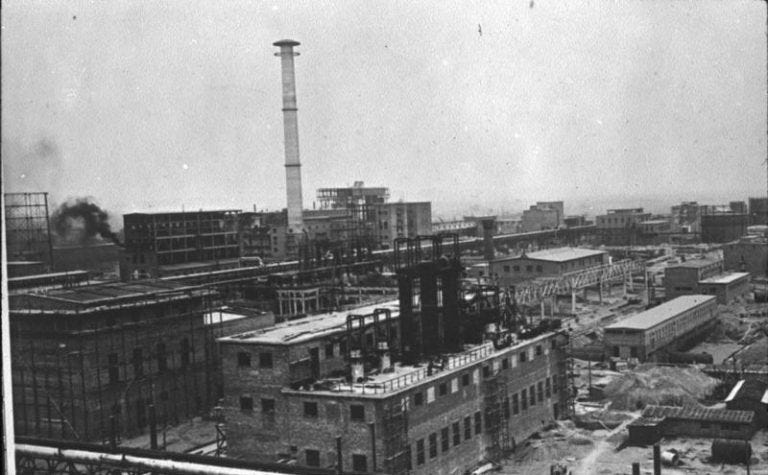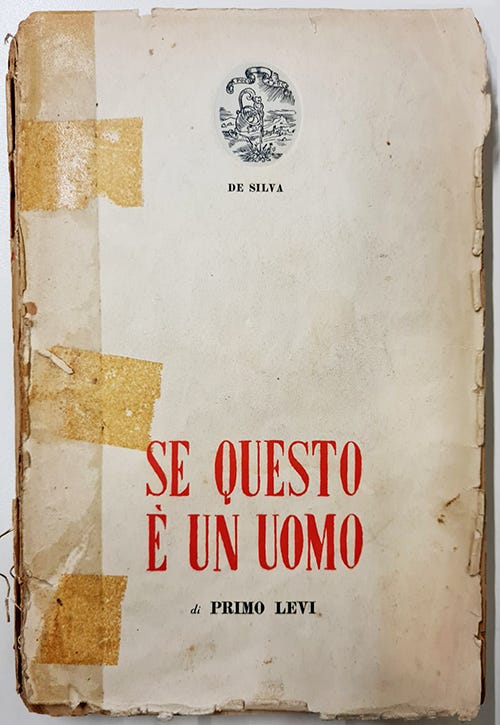If This Is a Man? The Testimony from Hell that Almost Never Saw the Light of Day
Immediately after being liberated from Auschwitz, the author Primo Levi began writing about topics others were afraid or unable to expose.
The Library of Babel is an email newsletter exploring the wonders of literature, history and magic. All the installments are free. Sign up here:
"If This Is a Man was written immediately after the events described in it," said the author Primo Levi in an interview years after the publication of the book that brought him international fame—the book that, in a first-person account with a clear voice, revealed the horrors of the Holocaust. Se questo è un uomo is the original title of the book, written in Italian. But Levi also referred to the book as "my firstborn," a child he struggled to bring into the world because the world was not ready to hear it and probably didn’t want to.
Levi was born in 1919 to a Jewish family in Turin, Italy. In 1941, he graduated with honors with a degree in chemistry from the University of Turin. In 1943, after the Nazis occupied northern Italy, Levi, then a 24-year-old chemist, joined a group of partisans. After a short time, they were captured, and Levi was sent to the Fossoli detention camp for Jews near the city of Modena. In February 1944, he was deported from there with 650 other Jews, transported in crowded freight cars for five days to Auschwitz, Poland. Levi was deemed fit for labor, his arm was tattooed with a prisoner number, and he was sent to perform forced labor at the Buna-Monowitz camp (Auschwitz III).
Primo Levi survived 11 months in the Auschwitz extermination camp. In his book If This Is a Man, he chillingly documents his life from the moment of his arrest until the liberation of Auschwitz by the Soviets on January 27, 1945.
If This Is a Man is a story of survival, almost by chance. Levi attributed his survival in a place where about one million Jews perished to a combination of fateful circumstances and events. First, Levi found a friend and protector in an unlikely place: Lorenzo Perrone, an Italian worker employed at the camp, smuggled Levi an extra portion of food each day, in addition to the meager rations allotted to the prisoners. For his efforts in saving Levi, Perrone was recognized in 1998 (posthumously) as Righteous Among the Nations. Additionally, after a period of forced labor, Levi was reassigned to work as a chemist in the camp laboratory, sparing him from the physical toil in the freezing cold and from torture. Finally, shortly before the forced evacuation of the camp as the Red Army approached from the east, Levi fell ill and was hospitalized in the camp infirmary. In their hasty retreat, the Nazis left the sick prisoners behind, including Levi, while the rest of the prisoners were forced to continue on what the Nazis called “a death march”. Eighty percent of the prisoners who had survived to that point perished during that march from Auschwitz. Levi never saw Lorenzo again.
After the camp was liberated, Levi embarked on a long, arduous journey that took nine months before he returned to his family home in Turin.
Levi’s statement that his book was written immediately after the events encompasses a far more complex story. In If This Is a Man, we learn that Levi had already begun scribbling down memories and documenting his experiences while working in the camp laboratory. However, he had to dispose of his notes, knowing that if he were caught with them, it would mean certain death.
Only in the second and final edition of If This Is a Man, published in 1958, did Levi include a note explaining where the book was written: “Avigliana – Turin, December 1945 – January 1947.” And thanks to the story "Chromium" in The Periodic Table, a collection of short stories Levi published in 1975, we learn about the conditions under which his Auschwitz memoirs were written—in a small, noisy office in the chemical factory where he worked after the war, as workers constantly came and went. It’s interesting to discover that the last chapter of If This Is a Man, the freshest in his memory, was the first one he wrote. In fact, Levi had no intention of writing a book; the memories he put to paper eventually coalesced into a chronological narrative.
Today, more than 75 years after the book was written, there is no debate that it stands as one of the most profound and important testimonies of the Holocaust, and certainly one of the earliest. But when Levi first sought to publish the book, he encountered a series of rejections. The saga of the book's publication sounds almost inconceivable today.
If This Is a Man was ready for publication at the beginning of 1947. After two publishers had already rejected it, Levi approached the major publishing house Einaudi in Turin. But they, too, decided to pass. After Levi’s death, the Italian-Jewish author Natalia Ginzburg, who served as an editor at Einaudi, spoke about the terrible mistake she made in passing on the book 40 years earlier.
Without a publisher, Levi began submitting chapters of the book to newspapers, and within a few months, three chapters were printed in two local newspapers in Italy. Ultimately, the book saw the light of day thanks to the intervention of Anna Maria, Levi’s sister. She sent the manuscript to the historian Alessandro Galante Garrone, who passed it along with a strong recommendation to his friend Francesco de Silva, the director of a small publishing house, also in Turin.
It was de Silva who gave the book its title, based on a quote Levi used as the book’s epigraph. De Silva published the 198-page masterpiece on October 11, 1947. Levi was asked to write a few sentences for a pamphlet to present his book to the public, and this is what he wrote:
"This book was not written as an accusation nor to incite fear. The message it carries is one of peace: those who hate violate the laws of reason before they violate the principles of morality."
It seemed that the combination of a sharp, talented publisher like de Silva and the commitment of a young writer driven by a sense of mission would break the wall of silence that was beginning to form around the Holocaust. But in reality, a limited edition of only 2,500 copies of If This Is a Man was printed, and of those, only about 1,500 were sold. Although the book received positive reviews, it was not widely read. In 1958, it was reissued in an expanded and revised edition by Einaudi, the same publisher that had rejected Levi a decade earlier. The updated book became a great success and was also translated into several languages. To this day, Levi's firsthand testimony and the power of his writing continue to captivate readers with the memories of a prisoner at Auschwitz.
In April 1987, Levi died after falling from a window of his apartment in Turin. At his request, his Auschwitz prisoner number was engraved on his tombstone.







Thank you Chen…. I ignored many things inside the witnessing story of this book… There are no possible words of comment. We must only not to forget. Thank you
I so enjoyed this post. Thanks for sharing Levi's story.